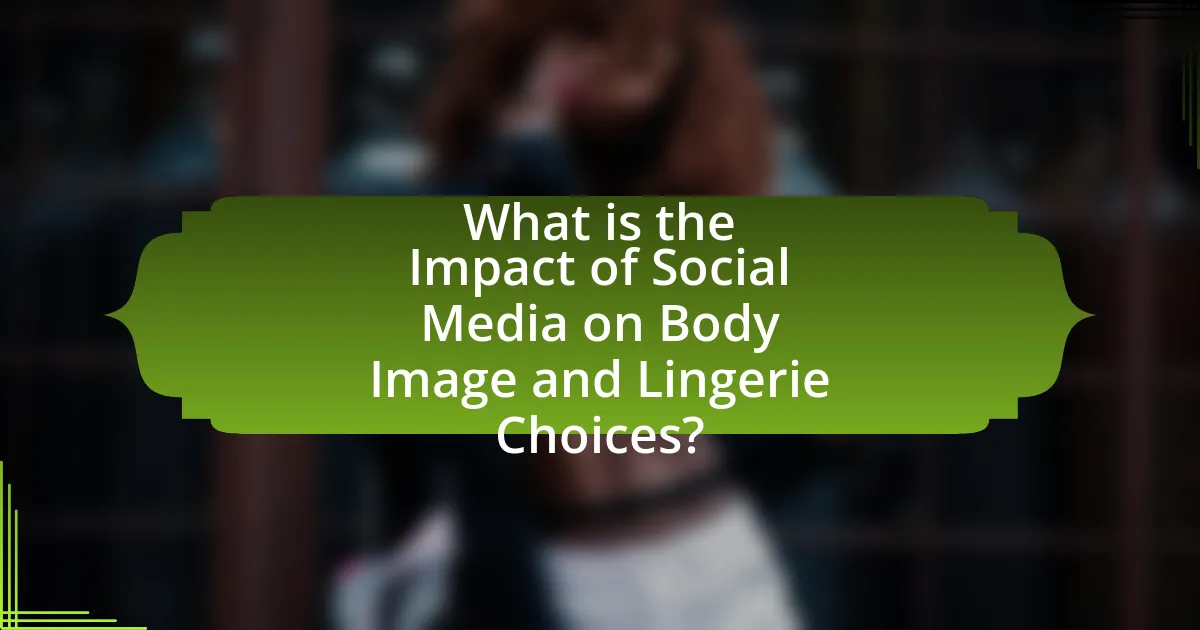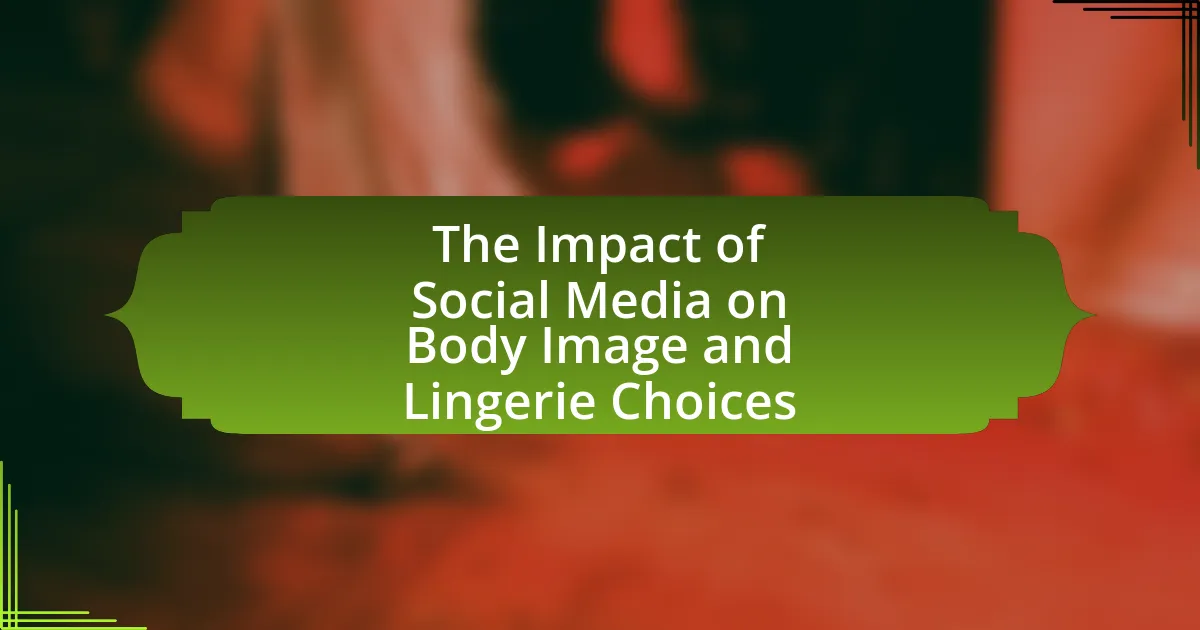The article examines the impact of social media on body image and lingerie choices, highlighting how platforms like Instagram and TikTok promote idealized beauty standards that can lead to body dissatisfaction and altered consumer behavior. It discusses the role of influencers in shaping perceptions of beauty, the dual nature of social media’s influence on body positivity and negativity, and the psychological effects of comparison culture. Additionally, the article explores how social media trends affect lingerie choices, popular styles, and consumer purchasing decisions, while offering strategies for individuals to navigate these influences and make informed choices that prioritize body positivity and self-acceptance.

What is the Impact of Social Media on Body Image and Lingerie Choices?
Social media significantly influences body image and lingerie choices by promoting idealized beauty standards and fostering comparison among users. Research indicates that exposure to curated images on platforms like Instagram can lead to body dissatisfaction, as individuals often compare themselves to the seemingly perfect bodies displayed. A study published in the journal “Body Image” found that women who frequently engage with social media are more likely to experience negative body image and may alter their lingerie choices to align with perceived societal standards. This shift often results in purchasing lingerie that emphasizes certain body types, reflecting the impact of social media on consumer behavior and self-perception.
How does social media influence perceptions of body image?
Social media significantly influences perceptions of body image by promoting idealized and often unrealistic standards of beauty. Research indicates that exposure to curated images on platforms like Instagram can lead to body dissatisfaction and negative self-esteem among users, particularly young women. A study published in the journal “Body Image” found that individuals who frequently engage with appearance-focused content are more likely to compare themselves unfavorably to others, resulting in increased body dissatisfaction. This phenomenon is exacerbated by the prevalence of edited and filtered images, which distort reality and set unattainable benchmarks for physical appearance.
What role do influencers play in shaping body image standards?
Influencers play a significant role in shaping body image standards by promoting specific ideals of beauty and body types through their platforms. Their curated content often highlights certain physical attributes, which can lead to the normalization of these standards among their followers. Research indicates that exposure to idealized images on social media can negatively impact self-esteem and body satisfaction, particularly among young women. A study published in the journal “Body Image” found that individuals who frequently engage with influencer content are more likely to experience body dissatisfaction and a desire to conform to the promoted standards. This demonstrates the powerful influence that social media personalities have in defining and perpetuating contemporary body image norms.
How do social media platforms contribute to body positivity or negativity?
Social media platforms contribute to body positivity by promoting diverse body representations and fostering supportive communities, while they also contribute to body negativity through the prevalence of unrealistic beauty standards and harmful comparisons. Platforms like Instagram and TikTok have seen the rise of body positivity movements, where users share images and stories that celebrate various body types, helping to challenge traditional beauty norms. Conversely, studies indicate that exposure to idealized images can lead to body dissatisfaction; for instance, research published in the journal “Body Image” found that individuals who frequently engage with appearance-focused content report higher levels of body dissatisfaction and lower self-esteem. Thus, the dual nature of social media’s influence on body image is evident, as it can simultaneously empower and harm users’ perceptions of their bodies.
Why are lingerie choices affected by social media trends?
Lingerie choices are affected by social media trends because platforms like Instagram and TikTok heavily influence consumer preferences and perceptions of body image. These platforms showcase diverse styles and body types, leading to increased visibility of various lingerie brands and trends. Research indicates that 70% of young women report feeling pressure to conform to beauty standards portrayed on social media, which directly impacts their lingerie purchasing decisions. As a result, social media not only shapes the aesthetic appeal of lingerie but also reinforces societal norms regarding body image, prompting consumers to align their choices with trending styles and influencers.
What types of lingerie are popularized through social media?
Popular types of lingerie that are popularized through social media include bralettes, bodysuits, and high-waisted panties. These styles have gained traction due to influencers and brands showcasing them in various contexts, emphasizing comfort and body positivity. For instance, bralettes are often highlighted for their versatility and appeal to a wide range of body types, while bodysuits are promoted for their seamless look under clothing. High-waisted panties have also become trendy, aligning with the growing movement towards embracing diverse body shapes. The visibility of these lingerie types on platforms like Instagram and TikTok has significantly influenced consumer preferences and body image perceptions.
How do social media campaigns affect consumer purchasing decisions?
Social media campaigns significantly influence consumer purchasing decisions by shaping perceptions and driving engagement. Research indicates that 54% of social media users utilize these platforms to research products before making a purchase, highlighting the role of social media in the decision-making process. Additionally, campaigns that feature relatable content and user-generated testimonials can enhance trust and credibility, leading to increased likelihood of purchase. For instance, a study published in the Journal of Advertising Research found that consumers are 71% more likely to make a purchase based on social media referrals, demonstrating the direct impact of social media campaigns on buying behavior.
What psychological effects does social media have on body image?
Social media significantly influences body image, often leading to negative psychological effects such as body dissatisfaction, low self-esteem, and increased anxiety. Research indicates that exposure to idealized images on platforms like Instagram can create unrealistic beauty standards, which in turn can result in individuals feeling inadequate about their own bodies. A study published in the journal “Body Image” found that frequent social media use correlates with higher levels of body dissatisfaction among adolescents, as they compare themselves to the curated images they see online. This comparison can foster feelings of inadequacy and contribute to mental health issues, including depression and eating disorders.
How does comparison culture on social media impact self-esteem?
Comparison culture on social media negatively impacts self-esteem by fostering feelings of inadequacy and low self-worth among users. Research indicates that frequent exposure to idealized images and lifestyles can lead individuals to compare themselves unfavorably to others, resulting in increased anxiety and depression. A study published in the journal “Body Image” found that individuals who engage in social comparison on platforms like Instagram report lower self-esteem and higher body dissatisfaction. This correlation highlights how the curated nature of social media content can distort self-perception and contribute to a negative body image.
What are the long-term effects of social media on body image perception?
The long-term effects of social media on body image perception include increased body dissatisfaction, distorted self-image, and heightened risk of eating disorders. Research indicates that prolonged exposure to idealized body types on platforms like Instagram and Facebook can lead individuals to develop unrealistic standards for their own bodies. A study published in the journal “Body Image” by Perloff (2014) found that frequent social media use correlates with negative body image and self-esteem issues, particularly among adolescents and young adults. Furthermore, a meta-analysis in “Psychological Bulletin” by Fardouly et al. (2015) confirmed that social media can exacerbate feelings of inadequacy and comparison, contributing to long-term psychological distress related to body image.
How can individuals navigate social media’s impact on body image?
Individuals can navigate social media’s impact on body image by curating their feeds to include positive and diverse representations of bodies. Research indicates that exposure to a variety of body types can reduce body dissatisfaction; for instance, a study published in the journal “Body Image” found that individuals who followed body-positive accounts reported higher self-esteem and body satisfaction. Additionally, setting time limits on social media use can help mitigate negative comparisons, as excessive exposure to idealized images often leads to detrimental effects on self-perception. Engaging in critical thinking about the content consumed, such as recognizing the use of filters and editing, further empowers individuals to maintain a healthier body image.
What strategies can help mitigate negative body image from social media?
To mitigate negative body image from social media, individuals can implement strategies such as curating their social media feeds to include body-positive content and unfollowing accounts that promote unrealistic beauty standards. Research indicates that exposure to diverse body types and positive messaging can improve self-esteem and body satisfaction. A study published in the journal “Body Image” found that participants who engaged with body-positive content reported higher levels of body appreciation and lower levels of body dissatisfaction. Additionally, setting time limits on social media use can reduce the frequency of negative comparisons, further supporting a healthier self-image.
How can users curate their social media feeds for positive influence?
Users can curate their social media feeds for positive influence by actively following accounts that promote body positivity, self-acceptance, and healthy lifestyles. Research indicates that exposure to positive content can enhance self-esteem and body image, as seen in studies where participants reported improved body satisfaction after engaging with uplifting social media posts. Additionally, users should regularly unfollow or mute accounts that perpetuate unrealistic beauty standards or negative comparisons, as this can lead to detrimental effects on mental health. By prioritizing content that aligns with their values and well-being, users can create a more supportive and affirming online environment.
What role does self-acceptance play in countering social media pressures?
Self-acceptance plays a crucial role in countering social media pressures by fostering resilience against unrealistic beauty standards. Individuals who practice self-acceptance are more likely to appreciate their unique qualities and body types, which reduces the impact of negative comparisons often perpetuated by social media platforms. Research indicates that self-acceptance is linked to higher self-esteem and lower levels of body dissatisfaction, as evidenced by a study published in the Journal of Health Psychology, which found that individuals with higher self-acceptance reported feeling less influenced by social media portrayals of beauty. This suggests that cultivating self-acceptance can serve as a protective factor against the adverse effects of social media on body image and lingerie choices.
What are the best practices for making informed lingerie choices in the age of social media?
To make informed lingerie choices in the age of social media, individuals should prioritize body positivity, seek diverse representations, and focus on fit and comfort. Body positivity encourages consumers to embrace their unique shapes, countering unrealistic standards often portrayed online. Seeking diverse representations involves following brands and influencers that showcase a variety of body types, which can help in understanding how different styles may look on oneself. Additionally, focusing on fit and comfort is crucial; research indicates that well-fitting lingerie can enhance self-esteem and body image, as supported by studies showing that comfort directly influences confidence levels. By integrating these practices, consumers can navigate social media influences effectively and make choices that align with their personal preferences and body types.



